I will focus more of this discussion on the first 20 years of the Navy’s plan, covering the years 2016 through 2035, because the third decade of the Navy’s plan is necessarily quite speculative. Nevertheless, keeping an eye on the longer, 30-year perspective is important. While it is true that the nature of warfare, technology, and costs cannot be predicted decades into the future, it is today’s decisions that are most important for the long-run perspective. The President proposes a budget and Congress makes appropriations year-to-year. The Department of Defense provides Congress with a five-year Future Years Defense Program (FYDP), but without the presence of the 30-year plan, the long-range effect on the Navy of the incremental decisions made in each year’s budget cycle would not be understood. For example, in the 1990s, the service built an average of one submarine every other year, and that low rate of construction had no effect on the existing inventory, because coming off the boon years of the 1980s, the attack submarine force was young. Submarine procurement could be reduced during the 1990s without affecting the existing force structure at all. But in the next decade those decisions would manifest themselves in a declining SSN force in a world that today looks like it will get more dangerous and more competitive, not less, and for which some observers of international and naval affairs think having more submarines would be a valuable asset for the Navy.
What to Buy and at What Cost?
Between 2016 and 2035, the Navy plans to buy 178 ships, including 12 expensive Ohio -class replacement ballistic-missile submarines. The rest of those purchases comprise 4 aircraft carriers, 28 attack submarines, 40 large surface combatants, 35 littoral combat ships (LCSs) and frigates, 16 amphibious ships, and 43 combat logistics and support ships.
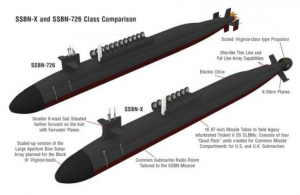
The Congressional Budget Office, in a report that I authored, estimates the cost of building those ships at an average $18.7 billion per year in Fiscal Year 2015 dollars. 2 But that amount is for new construction only. It does not include all of the other activities that the Navy must fund from its shipbuilding account, such as refueling aircraft carriers, outfitting and post-delivery, and other items. They add another $2 billion to the Navy’s funding requirements, resulting in an average shipbuilding budget of $20.8 billion per year for the next two decades.
The dilemma the Navy faces is that in recent decades shipbuilding budgets have been much lower. Since 1986, the Navy has received an average of only $15.8 billion per year, after adjusting for inflation, for all of its shipbuilding activities. And in the most recent decade, 2006–2015, it was even less—$15 billion. Thus, in order to fund the Navy’s plan, the shipbuilding budget will need to increase by an average of 40 percent compared to the past ten years, or about $6 billion per year.
As readers of Proceedings will know, the 800-pound gorilla in the room is the Ohio Replacement Program. The Navy plans to replace its aging force of 14 Ohio -class ballistic-missile submarines with a new, as-yet unnamed class of 12 boats, with procurement funding starting in 2017 and continuing through 2035. At around $6 billion apiece, buying those new boomers poses a substantial fiscal and budgetary challenge to the Navy. Declared to be the Navy’s top budgetary priority, the question, in the view of some members of Congress, is not whether the Ohio replacements will be funded, but rather how they will be funded. Will the Navy receive increases in its shipbuilding budget to pay for the new submarines, or will the Navy have to buy those submarines from a budget that is not increasing? If so, what happens to the rest of the fleet?
Future Fleet, Historical Funding Level
In the 2014 National Defense Authorization Act, Congress directed the Navy to assess what would happen to its shipbuilding plan if, on average, future shipbuilding budgets matched historical budgets. So far, the Navy has not responded to that congressional directive.
The CBO’s analysis shows that constraining future shipbuilding budgets to an average of $16 billion per year results in a much smaller fleet over time. The assumptions that were made in doing such an assessment were as follows:
• The Navy builds all 12 Ohio replacement submarines.
• Production of aircraft carriers is not cut, because Congress mandates the 11-ship force level in law.
• All other ship programs are cut roughly proportionately.
With those assumptions and applying the budgetary constraint, the Navy would purchase 131 ships over the next 20 years, instead of the 178 in the 2016 shipbuilding plan. Specifically, those purchases would include:
• 4 aircraft carriers
• 12 ballistic-missile submarines
• 18 attack submarines
• 25 destroyers
• 25 LCSs and frigates
• 12 amphibious-warfare ships
• 35 combat logistics and support ships.
Reducing the shipbuilding program by 47 ships over 20 years results in a fleet no larger than today’s by 2035. Over the entire 30 years of the Navy’s plan, the fleet would drift down to 237 ships if the historical funding level does not budge much from $16 billion. (See the accompanying table). That is a reduction of 13 percent compared to today’s Navy and 22 percent compared to the fleet of 2045 projected under the 2016 plan.
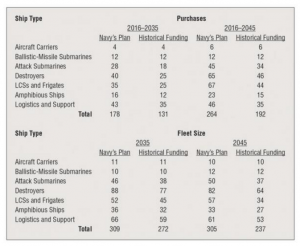
Is There a Solution?
What are the alternatives to a decline of the Navy’s fleet? Are the alternatives viable? Let us consider each one in turn.
Increase the shipbuilding budget. The first and immediately obvious solution would be to increase the size of the Navy’s shipbuilding budget. Shipbuilding represents about 3 percent of the overall defense budget, a relatively small fraction. As my counterpart at the Congressional Research Service, Ron O’Rourke, has noted in his work, increasing ship construction by $5 billion per year would represent less than 1 percent of defense spending. Yet, even such a small increase faces three powerful headwinds—one short-term, one long-term, and one that is a constant—that are political and budgetary in nature. In the near term, any increase in the defense budget faces the caps imposed by the Budget Control Act (BCA) of 2011 and the various amendments, including the Bipartisan Budget Act of 2015. While the BCA says nothing about how much of the DOD budget may be spent on any particular account, the fact that the BCA caps defense spending below the President’s 2016 FYDP makes it extremely difficult to find the money to increase any category of spending, including shipbuilding. The 2016 FYDP allocated $121 billion more for defense spending over the years 2016 to 2020 than the amounts allowed under the revised caps of the BCA. Thus, widespread cuts are the order of the day, not funding increases.
Although the BCA is set to expire in 2021, presumably making it easier to increase the defense budget in the long term, the large fiscal challenges facing the United States will not. Between now and 2040, the CBO projects that the demands by a growing older population and rising medical costs will increase spending on Social Security and Medicare by 27 percent and 80 percent respectively. But the dedicated revenues that support those programs will remain nearly flat. 3 Because federal deficits over that period will persist and increase the national debt, the CBO also projects that spending on interest will increase by 230 percent; at the same time, revenues from federal income taxes will increase by only 25 percent. Stiff competition for federal resources will remain a fact of our budget debates for decades to come, and the Navy will not be immune.
Finally, within the defense budget itself are the competing demands and priorities of the services and their supporters. If the military branches were unified in the perspective that naval shipbuilding, including the Ohio replacement, should be the nation’s first military priority—or at least the first acquisition priority—it might be a relatively simple thing to shift 1 percent of the defense budget in its favor. But that is not a universally held view. As the threats to U.S. national security become more varied in this emerging new strategic era, the competing demands of all parts of the military for more resources make shifting even a small amount of the defense budget a difficult proposition, especially with the demands on federal resources continuing to grow. 4
Adopt alternative ship designs and fleet architecture. If more money does not flow into the Navy’s shipbuilding accounts, what are the other alternatives? Are there ways to squeeze more out of the current budget? Can you keep ships around longer and modernize them? Does the Navy really need to buy the fleet it is proposing, or would an alternative be better? These are large, wide-ranging questions that deserve serious attention and debate. My purpose in raising and discussing them briefly in this article is to show that even if such suggestions were adopted, they would have little effect on the fleet over the next 10 years and only a marginal effect over the next 20 years.
Let us very briefly consider two examples of alternative fleet architectures proposed by two knowledgeable and experienced men in the business of fleet design: Captain Arthur “Trip” Barber and Captain Wayne Hughes. 5Both are retired Navy officers who then spent many more years thinking about alternative fleet architectures and ship designs. They still do.
In a 2014 Proceedings article, Captain Barber recommends that the Navy do a number of things differently in what he sees as an unending period of federal fiscal constraint. He suggests changing the capabilities of existing ship platforms as well as changing the ways the Navy deploys or stations ships in order to get more deployed time out of these expensive capital assets. However, he also recommends exploring several alternative ship designs that, he argues, would reduce shipbuilding costs, including using a single new ship design for both aircraft carriers and large-deck amphibious-assault ships, developing several classes of surface combatant that perform different missions but share a common hull, and repeating that common-hull approach for various support-ship missions.
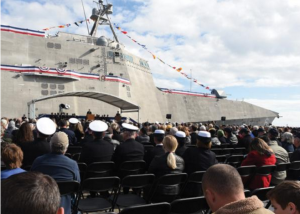
Captain Hughes equally reimagines the future fleet, although he believes his plan is affordable within existing shipbuilding budgets. The New Navy Fighting Machine, as Captain Hughes describes it, would develop even more new ship types than would Captain Barber’s. Specifically, Captain Hughes envisions new conventionally powered submarines, light aircraft carriers, small land-attack arsenal ships, and a substantial green-water force, as well as continuing to build numerous ship types that are already part of the Navy’s 2016 plan.
Nevertheless, however thought-provoking the suggestions offered by both men, making such major changes to the fleet will not be easy or quick. Alternative ship designs and fleet architectures take a long time to implement. For example, the LCS was first proposed in 2001. Fifteen years later the Navy has commissioned six of those small, relatively inexpensive 3,000-ton ships. A large all-new ship design, such as the DDG-1000 Zumwalt -class destroyer, has been in development, design, and construction for 20 years and won’t commission into the fleet until later this year. The same is true for the new Ford -class aircraft carrier. Under the Navy’s shipbuilding plan, in 15 years—2031—the Navy will have only eight new combat ships of entirely new design: three Ford -class carriers, three Zumwalt -class destroyers, and two Ohio replacement ballistic-missile submarines. Another 48 combat ships will be commissioned that have a modified design of existing warships: 21 Arleigh Burke –class Flight III destroyers, 20 frigates based on the LCS (or just 12 under Secretary Carter’s directive), and seven LX-R amphibious ships based on the existing LPD-17 hull. The Navy will also have another 28 combat logistics and support ships of some new type. Overall, in 2031 at least three-quarters of the fleet will still be composed of ships with designs that are in service today.
Thus, unless the ship-acquisition process can be changed such that it dramatically speeds up the introduction of new ship designs into the fleet, most of the suggestions by Captains Barber and Hughes would not have a meaningful effect on the composition of the fleet until, coincidentally, the Ohio Replacement Program is essentially completed in 2035. This is a point that Captain Hughes explicitly acknowledges and addresses (and one that Captain Barber recognizes but does not address), but, based on the Navy’s acquisition history, the former may be optimistic about what is achievable in 10–20 years. 6
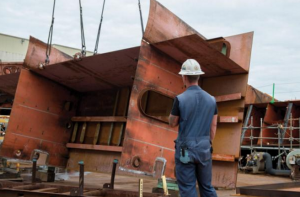
Keep older ships in the fleet. A less time-intensive alternative to new ship designs or fleet architectures would be to modernize older ships and keep them in the fleet. But this approach has its own problems. Paradoxically, the Navy is already doing this to a large extent, so it is not clear that more can be done, but also historical experience suggests that the service dislikes doing so. Over the past 20 years, senior Navy leaders have extended the service lives of more than 100 submarines, destroyers, and amphibious ships relative to their original design lives. At the same time, the Navy retired dozens of ships that had many years of useful service life remaining, rather than purchasing slightly fewer new ships to pay for keeping the older ships in the fleet.
Specifically, in the early 2000s, the Navy increased the service life of the Ohio -class ballistic-missile submarines from 30 years to 42. If that had not been done, we would have debated the merits and means to pay for the Ohio replacement more than a decade ago, when the United States was fully engaged in two wars in Afghanistan and Iraq. Similarly, the service life of Los Angeles –class attack submarines was increased from 30 years to 33. The Navy now assumes its large-deck amphibious-assault ships will serve for 43 to 45 years, which is up from 40 years. And since the release of the 2009 shipbuilding plan, the Navy has assumed its Arleigh Burke –class destroyers would serve in the fleet for 40 years, rather than 35 years in earlier plans, which is up from the original design life of 30.
Extending the service lives of these ships further is impossible in some cases and questionable in others. The submarines will be at the limit for the number of cyclings (submerging and surfacing) that their pressure hulls can tolerate, and the energy in their reactors will be exhausted. Conventionally powered surface ships, however, could in theory be upgraded if the Navy chose to do so. Properly maintained, conventional hulls can last for many decades. Ships that were retired from the U.S. Navy and sold or transferred to other countries often serve for decades longer as a result. But at a certain point, a ship that is still useful in a South American or Asian navy would no longer be valuable to the U.S. Navy, because physical limitations may prevent a modernization of her combat systems to perform high-end missions. Further, keeping older ships in the fleet even longer would require the Navy to modernize combat systems and fully fund maintenance programs. But budgetary constraints and long, frequent deployments have made it hard for the service to do so. Thus, if it is not clear that Burkes can serve for 40 years, it seems even less likely they could serve for 45 to 50 years performing missions the Navy would find valuable.
At the same time the Navy was extending the service lives of some ships, it was retiring others well before the end of their design lives. In the late 1990s through the mid-2000s, the Navy retired the entire class of Spruance destroyers. To keep those ships in the fleet the Navy would have had to spend money on improving their material condition as well as upgrading their combat systems. It also would have cost money to continue to operate those ships. But a decade later, the surface-combatant force is overworked with long deployments because there are insufficient ships to meet the demand. In addition, the original plan was to retire the Oliver Hazard Perry –class frigates sooner and keep the Spruances around, but that decision was reversed because it was cheaper to operate the smaller ships. Relative capabilities apparently did not figure strongly in the decision.
Similarly, the Navy retired 17 Los Angeles –class attack submarines at an average age of 22 years, rather than pay to refuel those boats and keep them in the fleet. Paying for all 17 refuelings would have cost less than the price of two new Virginia -class submarines. Again, the Navy would have had to budget resources to operate those ships, but at about $40 million per submarine per year, that was not an insurmountable obstacle.
And more recently, the Navy proposed to retire seven Ticonderoga -class cruisers and two amphibious ships to help conform to the budgetary caps of the Budget Control Act, rather than reduce new ship purchases further. Congress intervened, however, directing the Navy to keep those ships in the fleet and provided additional appropriations to do so. But if the Navy had had its way two years ago, the fleet today would number 264 ships. In that event, the strain on large surface combatants and amphibious ships, which now routinely deploy for seven to ten months, would be even greater.
Size? Capabilities? Both?
One way for a policymaker or anyone interested in naval matters to think about these issues is to figure out what your objective is. Do you care most about the size of the fleet? Or are the capabilities of the fleet more important? Of course, both are important. But the tension between size and capabilities is in many ways a proxy for the tension between the Navy’s day-to-day responsibilities and its high-end warfighting requirements. In an unendingly tight fiscal environment, a larger Navy is one that is better able to provide overseas presence and perform the many, varied peacetime missions that our naval forces are routinely called on to conduct—without overly stressing the ships and crews. 7 However, ships with the high-end warfighting capabilities that would be needed in an unlikely, but far from impossible, future conflict with a peer or near-peer competitor are expensive. The Navy cannot afford to build as many of them as it would like under historical funding levels.
If this seems like a daunting set of challenges for shipbuilding, that’s because it is. Yet, it may be possible that a little bit of everything could close the gap. If the Congress can shift a fraction of 1 percent of the defense budget toward shipbuilding, if improving acquisition can squeeze a fraction of 1 percent of the defense budget toward more shipbuilding, and if the Navy invests in some of its older ships to keep them in service, then perhaps it can step off the path toward a fleet of 237 ships that history says it is on. But that combination of outcomes would be difficult to achieve.
Dr. Labs, writing here as a private citizen, is Senior Analyst for Naval Forces and Weapons at the Congressional Budget Office. He specializes in issues related to the procurement, budgeting, and sizing of the forces for the Department of the Navy. Dr. Labs has testified before Congress several times and published numerous studies under the auspices of the CBO as well as a number of articles and papers in academic journals and conferences.
1. Report to Congress on the Annual Long-Range Plan for Construction of Naval Vessels for Fiscal Year 2016 (Washington, DC: Department of the Navy, March 2015), http://tinyurl.com/ocrqtfc [8] .
2. Congressional Budget Office, An Analysis of the Navy’s Fiscal Year 2016 Shipbuilding Plan , October 2015, www.cbo.gov/publication/50926 [9] .
3. Congressional Budget Office, The 2015 Long-Term Budget Outlook , June 2015, www.cbo.gov/publication/50250 [10] , 3.
4. Ronald O’Rourke, A Shift in the International Security Environment: Potential Implications for Defense—Issues for Congress , Congressional Research Service, 20 November 2015,www.hsdl.org/?view&did=788858 [11] .
5. CAPT Arthur H. Barber, USN (Ret.), “Rethinking the Future Fleet,” U.S. Naval Institute Proceedings , vol. 140, no. 5 (May 2014), 48–52. CAPT Wayne P. Hughes, USN (Ret.), The New Navy Fighting Machine: A Study of the Connections Between Contemporary Policy, Strategy, Sea Power, Naval Operations, and the Composition of the United States Fleet , (Monterey, CA: Naval Postgraduate School, 2009). See also his “A Bimodal Force for the National Maritime Strategy,” Naval War College Review , vol. 60, no. 7 (Spring 2007), 29–47.
6. Megan Eckstein, “CNO: Navy Needs More Agile Procurement to Keep Pace with ‘4-Plus-1’ Threat Set,” USNI News, 7 December 2015, http://news.usni.org/2015/12/07/cno-navy-needs-more-agile-procurement-to… [12] .
7. Congressional Budget Office, Preserving the Navy’s Forward Presence With a Smaller Fleet , March 2015, www.cbo.gov/publication/49989 [13] .
Featured Image Credit: Chris Oxley.

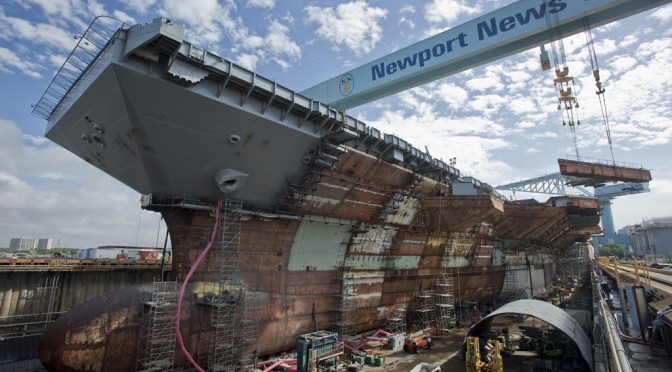
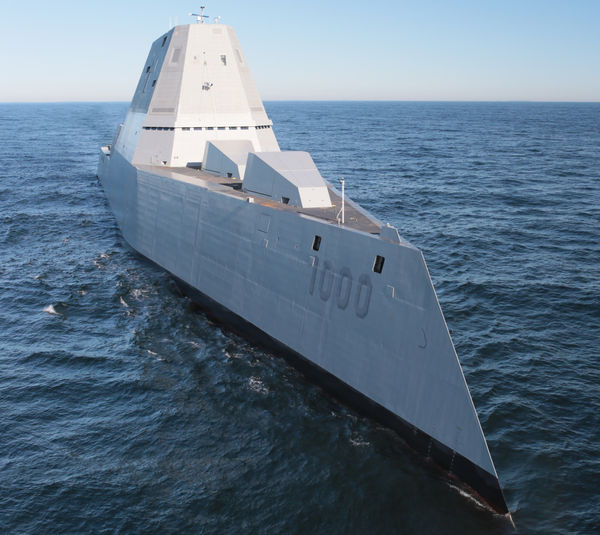
Perhaps there are some other options that should be considered. In the future a very large part of the USN fleet will have to operate in SE Asia and the Pacific ocean. Helping US allies carry more of the burden would help e.g. sell/lease Virginia class boats to Australia which is currently only evaluating diesel options. Apart from the commercial benefits to the USA, the operational benefits of having the same class of boat within the same region are obvious. Some not so obvious benefits:
1. Australia could then cover the Indian Ocean as well
2. Australia could set up a maintenance facility for Virginia class boats that would enable Australia to also maintain the USN boats operating in that region. That would make the USN boats more productive by saving the trip back to the US then back again on patrol for maintenance. It would also make it more attractive for Australia to choose this option for the Future Submarine contract.
Unfortunately the US is not trying to sell Australia the Virginia class, only the Virginia combat system and weapons. A serious oversight I would suggest.